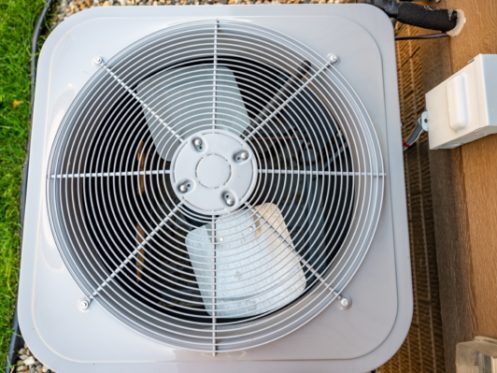Whether you’re installing an HVAC system in a new construction or replacing an old one, getting the right size is critical. While it’s tempting to guess the size you need, getting the proper size requires a little work and know-how. Discover what heating and cooling professionals mean by HVAC size, why it’s so important, and the factors that influence your needs.
What Does HVAC Size Mean?
Let’s start by discussing what we mean when we talk about HVAC size. This refers to the heat transfer capacity the system has, to either heat or cool your home.
The common measure of capacity is BTU or British Thermal Units. A single BTU is the amount of heat needed to raise one pound of water by one degree Fahrenheit.
In some cases, you may find HVAC systems rated by tons or tonnes. This is just a simplified form of the BTU rating, where 1 tonne equals 12,000 BTU.
Why Is HVAC System Size Important?
It’s tempting to ignore HVAC size and simply focus on the cost, especially with higher capacity systems costing more. However, this mentality ultimately costs you in the long run.
Both oversized and undersized units use more energy to run than those properly sized. Smaller units will run constantly, while oversized units will short cycle. In both cases, you’ll never quite experience the comfort you’d expect from your system.
In addition to raising your utility bills, an improperly sized unit will also cost more in repairs and have a shorter service life. Both long cycles and short cycling is hard on your system, increasing the operational strain. Components like your igniter, thermocouple, blower motor, and AC capacitor will wear out more quickly. As more components wear out, you eventually get to a point where you have catastrophic failures that require a system replacement.
Professionals Use HVAC Load Calculations
As you talk with your friends and family, they may recommend simply using your home’s size to determine your HVAC needs. While your home’s area is the base factor for sizing an HVAC system, it is not the only thing to consider.
Professionals use a standard calculation called the Manual J calculation to get to your specific needs. This doesn’t actually give you the size needed but calculates how much heat your home generates and loses. This information then gives your technician the information needed to recommend both the size and style of an HVAC system.
Start With Home Size
Just like you’ve likely heard from many people, the initial part of the calculation is your home’s size. However, there are a few considerations you need to account for when determining the size.
The first is the actual serviceable square footage of your home. Some recommend simply measuring the perimeter of your home and using that to calculate the square feet. However, that doesn’t always hold true. For instance, if your home has an attached garage, you need to remove that if you don’t run heating and cooling to the space. If you have an attic that you heat or cool, you’ll need to consider that as well, increasing your size.
Finally, square footage doesn’t accurately reflect the job of your HVAC system being that’s only two-dimensional. Your HVAC system heats the air, which is three-dimensional and includes height. The Manual J calculation actually works on cubic feet to account for the differences from one room to another.
The best way to calculate the serviceable cubic feet is to go through each room serviced by the system. Calculate the square feet and then multiply by the ceiling height. Where this becomes critical is any room with high or vaulted ceilings, which significantly increases the room’s cubic feet.
Consider Your Home’s Construction
Next, various factors of your home’s construction are as much a consideration as the actual size. This is where you start evaluating how much heat your home transfers to and from the world outside.
First up is the insulation in your home, including both in your walls and in your attic. If your home doesn’t have the right amount of insulation, it’ll transfer more heat, requiring more work from your HVAC system to keep it at the right temperature.
Next, you’ll need to consider your doors and windows, both in terms of size, construction, and number. Your technician will consider the kinds of windows, such as single pane versus gas-sealed double paned, along with the kind of doors you have installed. The idea is to gauge how much heat these allow to transfer while closed and how much the doors transfer when they’re opened.
What About Your Home’s Environment?
After your home’s construction, technicians will evaluate your home’s environment, both exterior and interior. How your home faces along with the amount of shade it receives are important to consider when evaluating your heating and cooling needs.
Next, they’ll look at the environment inside your home. They’ll be evaluating heat-generating appliances to understand how they affect your heating and cooling. The obvious ones are your kitchen and laundry appliances. However, this also includes major electronics. High-powered computers and specialized lighting are great examples of additional heat sources.
Don’t Forget About Occupants
Now it’s time to turn your attention to the number of occupants you have in your home. Each person generates body heat, which transfers to your home’s air. Most initial calculations account for two occupants in the home. Each additional occupant may increase your cooling capacity but may decrease your heating needs.
Beyond the people who live with you, it’s important to also consider the number and frequency of visitors. If you entertain frequently, you’ll want to account for some extra cooling capacity. Make sure to discuss this with our technicians to see if it’s a factor for your home and lifestyle.
Consider Lifestyle
Speaking of lifestyle, other parts of your lifestyle may affect your heating and cooling needs. Going back to your appliances, if you run a specialty kitchen from your home that you’re using beyond normal meal prep, that may affect your needs.
How you use your home also becomes an important consideration, especially if you have a larger home. Consider whether there are areas of your home that have different temperature needs than the rest. This could be a home gym or office, but it could also be a nursery or an elderly parent’s bedroom.
Taking all of this into consideration helps you find the best system for your particular situation. Remember, not all homes of the same size need the same HVAC system, so look for what will meet your specific needs.
It’s Not Only About Size, But Kind
As previously mentioned, our technicians will work to find both the right size and kind of HVAC system. The customary system is the central forced air system that uses a single air handling unit and ducts to deliver conditioned air. Even within those customary systems, you’ll want to evaluate whether a high-efficiency system or even a zoned system is a better fit.
If you’re installing a system in a new home, ductless mini splits may offer a better solution than the customary system. Our technicians can walk you through the options and why one may suit your home better than another. Ultimately, getting the best fit system for your home reduces your energy bills and the number of repairs and helps extend the system’s service life so that you have a lower annualized cost.
When people around Santee want trusted service to keep them comfortable, they call the team at Tarpy Plumbing, Heating & Air. Our expert team provides heating and cooling installation, maintenance, and repair together with a full range of residential plumbing services. Call to schedule your consultation with one of our friendly technicians to discuss installing a new or replacement HVAC system today.


 SPECIALISTS
SPECIALISTS

